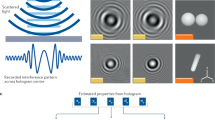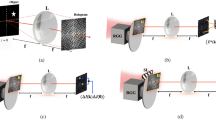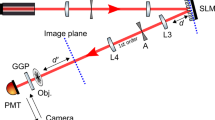Abstract
DURING a discussion at Cambridge, the idea was put forward that it might be possible to eliminate the effects of the unwanted image in diffraction microscopy by taking a subsidiary hologram and subtracting it from the reconstruction. In Gabor's method1,2 a single hologram is used, and he has shown how two images are formed, when coherent light traverses this hologram, so that the image in sharp focus has as a background a confused pattern due to the other image. In a recent note in Nature3, an elementary explanation of the origin of these two images is given; the confusion they cause is the necessary price paid for the loss of information as to the phase of the disturbance in the plane in which the main hologram is taken. But in a coherent beam, if the amplitude and phase are known over a surface 1, they can be calculated over a subsequent surface 2 by Huyghens's principle. In general, the two patterns differ from one another, yet they both contain essentially the same information. This opens up the possibility that the confusion due to loss of information about phase in one plane, the main hologram plane, may be cleared up by measuring the amplitude in another plane which we call that of the auxiliary hologram. In other words, two suitably separated amplitude patterns will do service for a single pattern giving both amplitude and phase. While one hologram gives two images, two holograms can be made to give one image.
This is a preview of subscription content, access via your institution
Access options
Subscribe to this journal
Receive 51 print issues and online access
$199.00 per year
only $3.90 per issue
Buy this article
- Purchase on Springer Link
- Instant access to full article PDF
Prices may be subject to local taxes which are calculated during checkout
Similar content being viewed by others
References
Gabor, D., Nature, 161, 777 (1948).
Gabor, D., Proc. Roy. Soc., A, 197, 454 (1949).
Bragg, W. L., Nature, 166, 399 (1950).
Haine, M. E., and Dyson, J., Nature, 166, 315 (1950).
Rogers, G. L., Nature, 166, 237 (1950).
Rogers, G. L., Proc. Roy. Soc. Edin. (in the press).
Author information
Authors and Affiliations
Rights and permissions
About this article
Cite this article
BRAGG, W., ROGERS, G. Elimination of the Unwanted Image in Diffraction Microscopy. Nature 167, 190–191 (1951). https://doi.org/10.1038/167190a0
Issue Date:
DOI: https://doi.org/10.1038/167190a0
This article is cited by
-
Megahertz-rate shock-wave distortion cancellation via phase conjugate digital in-line holography
Nature Communications (2020)
-
Digital in-line particle holography: twin-image suppression using sparse blind source separation
Signal, Image and Video Processing (2015)
-
Monolithic focused reference beam X-ray holography
Nature Communications (2014)
-
Twin image elimination in digital holography by combination of Fourier transformations
Journal of Optics (2014)
-
On the elimination of DC in reconstructed wavefronts from in-line holograms
Pramana (1978)
Comments
By submitting a comment you agree to abide by our Terms and Community Guidelines. If you find something abusive or that does not comply with our terms or guidelines please flag it as inappropriate.



